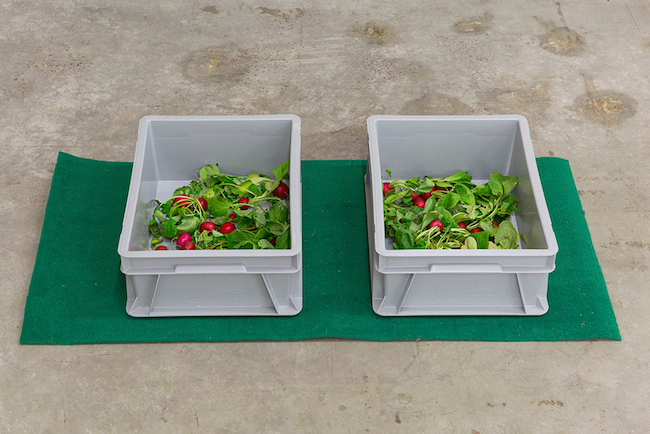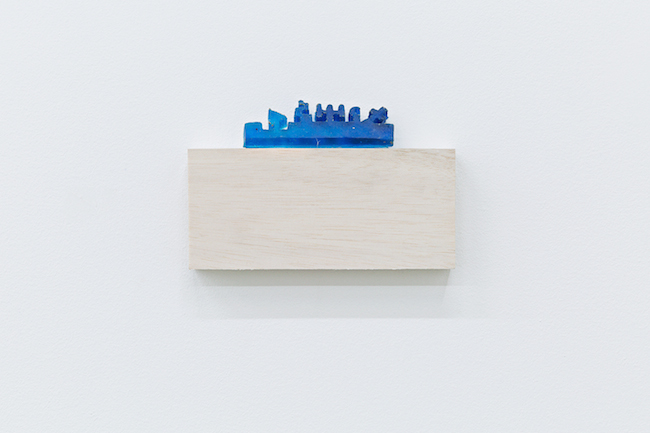
The economy of an object as a gesture
Weronika Trojańska*
17/04/2017
Olli Keränen’s “Fount” and Mikko Kuorinki’s “Leg Sleep Drop Deep”
SIC, Helsinki
Through April 23, 2017
We often don’t know how to behave when we find ourselves surrounded by sculptural objects spread out in the gallery space, especially when the things we look at resemble something familiar, but upon closer inspection, turn out to be different than we initially thought. We may feel lost, or even be left with a feeling of “I don’t get it”. What is it that you notice first? And why is it that specific thing, and not the one next to it or across from it? How do you move, behave, and even look in the vicinity of these objects? Would you do these things any differently if they were placed in your bedroom, or if you happened to come across them while walking in the forest? What would they communicate then?

Mikko Kuorinki. Leg Sleep Drop Deep, SIC, exhibition view
Both of the current exhibitions at SIC, a space for contemporary art in Helsinki, seem to ask these questions. Olli Keränen’s “Fount” and Mikko Kuorinki’s “Leg Sleep Drop Deep” create new languages for seemingly ordinary items and materials, and thus allow for the rise of new ways of perceiving and understanding them.

Mikko Kuorinki. Nose (2015)
The first thing the viewer encounters upon entering “Leg Sleep Drop Deep” is a bell hanging from a chain in the ceiling. The title says “Altered parrot cage toy”. Right behind it is a transparent pedestal on which an almost invisible glass teapot sits. Its spout, filled with mayonnaise, seems to be levitating in the air, which trivially brings to mind “Alice in Wonderland”. Three wooden structures with dark gray packing rugs hanging over them look like carpet-beating racks. “Meditation platform”, says the title of each one.

Mikko Kuorinki. Radish Walk (2017)
Most of the works in the show could be seen as revisions of objects altered from the domestic environment. Metal chair parts, t-shirts, radishes, matting, or even a hat encourage the visitor to investigate the surface (literally and metaphorically) of these everyday items. After all, iron would never shrink like a vegetable. Sculptures made of cheap materials, like wood or clay, look like they have been constructed by amateur craftsmen, or have been recycled from other sources, and now – being placed in the gallery space - they have gained a new life. They lose their attributed context when other objects and the viewer come into play. The layout of “Leg Sleep Drop Deep” is somehow reminiscent of the set design for a theater play, as if it has been arranged for something that is about to happen.

Mikko Kuorinki. Meditation platform (2017), A day at the beach (2017)
We use our lives and the connection that we have to others, as well as how we move around, to build associations to the things that we see. Kuorniki’s work questions our common perception of the world. Like poetry does, in a way. One of the halogen bulbs in the room has a green glow caused by liquid chlorophyll (as explained in its title – “Liquid chlorophyll in fluorescent tube”), as if it comes from the Frank O’Hara poem that starts with the following words: “The fluorescent tubing burns like a bobbie-soxer’s ankles”.

Olli Keränen. Guide (Woods), 2017
“It often feels like I’m writing with objects when I install them in a space”, says the artist. I believe that there are different ways of “reading” an exhibition. Just like writing verse apparently gives one more freedom than writing fiction, although the structure seems to be more controlled and well thought-out. “Leg Sleep Drop Deep” requires the kind of attention that is needed to read a poem (as opposed to the kind required for prose). Its narrative is created not by a chain of events, but by the associations that exist between separated entities (objects) and the viewer.

Olli Keränen. Ware (Crystal), 2017
Similar principles seem to motivate the second show, “Fount”, by Olli Keränen. “I feel the need to keep the objects as far away from narrative rewards as possible, but I also find myself always thinking of fictional characters that seem to yearn for meaning in the situations that I imagine them being in,” says the artist. In “Fount”, there is “a character who finds it irritating that the woods are turning out to be a sort of uncomfortable and drafty living room.”

Olli Keränen. Ware (Crystal), 2017
Seemingly functional sculptural objects carry the idea of bringing layered structures and a set of skills, developed in the city, into the wilderness of the forest. Just like when you enter the gallery, you manoeuvre through the exhibition with your whole body and with everything that you already know. Nevertheless, the gallery seems to be more of a natural habitat for the works than for the visitors. Much like “Leg Sleep Drop Deep”, Keränen’s objects don’t dominate the space; rather, they inhabit it, living in harmonious symbiosis. And although they were brought (“planted”) to the exhibition room intentionally, they look as they have grown from that spot. Even if their regular arrangement outwardly contradicts the way it would happen in nature.

Olli Keränen. Fount, 2017
The sculptures look like relics that carry a patina of age. They seem to be suspended between past and present, balancing from ritualistic to utilitarian purposes and back again. It creates a weird tension, as if there is another story that takes place simultaneously among them, independently of what is going on at the gallery. The works behave like chameleons, camouflaging their true origins. They look like things we know: ceramic bathroom tiles, gutters, a fountain basin, a backpack, a drainpipe, or even trash. In fact, they came from an artist’s studio. There is actually an object resembling a leg, as if it were a reference to the title of Kuorinki’s show. It made me think of Paul Thek’s assignments (“Teaching Notes”): “Design a flying saucer as if it were The Arc. / Redesign a rainbow. Make a French-curve rainbow”.

Olli Keränen. Fount (detail), 2017
Both “Leg Sleep Drop Deep” and “Fount”, although they are separate shows, seem to exist in a peculiar state of synergy. They are engaged in a dialogue, but not in a conversational one; yet there is an exchange of information taking place – like having a brief encounter with a stranger, and after having exchanged just a few sentences, you know whether you have something in common or not.

Olli Keränen. Guide (Home), 2017
Keränen and Kuorinki, being faithful to austerity and economy of the gesture, draw inspiration from daily life. By escaping narrative and leaving things in an open conversation, they are able to take the presence of the gallery visitor into consideration. Living in a constellation of things that come from everywhere, we are able to make associations with objects that we clearly recognize; as they stream into our mind, they help us give meaning to the work. www.sicspace.net
*Bio: Weronika Trojańska is an artist and art writer. She graduated from Academy of Fine Arts (Art Criticism and Art Promotion) in Poznań and Sandberg Instituut (Fine Arts) in Amsterdam. In her practice she investigate the notion of artists’ auto/biography as fictional construct. She writes regularly for art magazine Metropolis My, among others. Currently she lives and works in Poland.